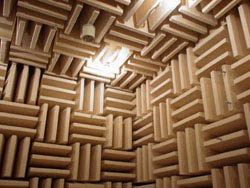10 Unit Three, Part Two: Room Acoustics and Sound Treatments
When I set up my first home basement studio, one of my biggest concerns involved keeping the noise out of my neighbors’ living spaces. In fact, during some of the “louder” sessions, that might have been my only concern since my small place sat smack dab in the middle of a populated neighborhood with houses stacked right next to each other. The couple next door often looked at us suspiciously as vans parked in front of their porches and off-loaded giant amps into my basement door. I made sure I stuffed the window spaces with old blankets. I stapled large pieces of packing foam to the ceiling space above the drum riser. My friends helped me build home-made sound baffles out of wood pallets and carpet pieces.
It worked pretty well. The rest of my house shook anytime we recorded a band in the basement. But the noise didn’t carry very far once outside the exterior walls. In the eight years that we recorded in that little basement, we only had one “official” noise complaint.
But, for all that amateurish sound proofing, nothing I stapled to the walls or stuffed under the doors did much to improve the audio inside the studio. I did not have the technical know-how for managing audio as it bounced off of walls, air vents, and ceilings.
Later, when I worked in bigger and more professional studios, I definitely noticed that whoever designed those spaces took time to consider how sound moved around the different rooms. They weren’t just trying to keep the neighbors happy; they were also making the inside of the studio sound better. I saw that a room’s reverberation could be controlled with curtains pulled across walls. I noticed that the corners by the ceiling had canvass covered blocks to absorb or deflect unwanted noises. Double paned plexiglass baffles stood around the drums. The distance and direction of the monitor speakers was measured and adjusted to a fixed point. This took not only technical knowledge, but method played a big roll as well. How far to pull the sound absorbing curtains across the wall seemed as important as choosing the right microphones.
If I could go back and re-design my old basement studio, I would certainly use those acoustic treatments I learned at the more professional studios. I never considered treating the corners of the ceiling with any sort of sound diffuser or absorber. The ability to control the sound in a recording room allows for more creativity in the long run.
Below are various links and other informative material on room acoustics and sound treatments.
How to Set Up Your Home Monitor Speakers
Acoustic Panels–What and Where
Soundproofing is any means of reducing the sound pressure with respect to a specified sound source and receptor. There are several basic approaches to reducing sound: increasing the distance between source and receiver, using noise barriers to reflect or absorb the energy of the sound waves, using damping structures such as sound baffles, or using active anti-noise sound generators. There are 5 elements in sound reduction (Absorption, Damping, Decoupling, Distance, and Adding Mass). The “Absorption” aspect in soundproofing should not be confused with Sound Absorbing Panels used in acoustic treatments. “Absorption” in this sense only refers to reducing a resonating frequency in a cavity by installing insulation between walls, ceilings or floors. Acoustic Panels can play a role in a treatment only after walls or ceilings have been soundproofed, reducing the amplified reflection in the source room.
Two distinct soundproofing problems may need to be considered when designing acoustic treatments—to improve the sound within a room (see reverberation), and reduce sound leakage to/from adjacent rooms or outdoors (see sound transmission class and sound reduction index). Acoustic quieting and noise control can be used to limit unwanted noise. Soundproofing can suppress unwanted indirect sound waves such as reflections that cause echoes and resonances that cause reverberation. Soundproofing can reduce the transmission of unwanted direct sound waves from the source to an involuntary listener through the use of distance and intervening objects in the sound path.
An anechoic chamber, showing acoustic damping tiles used for sound absorption.


